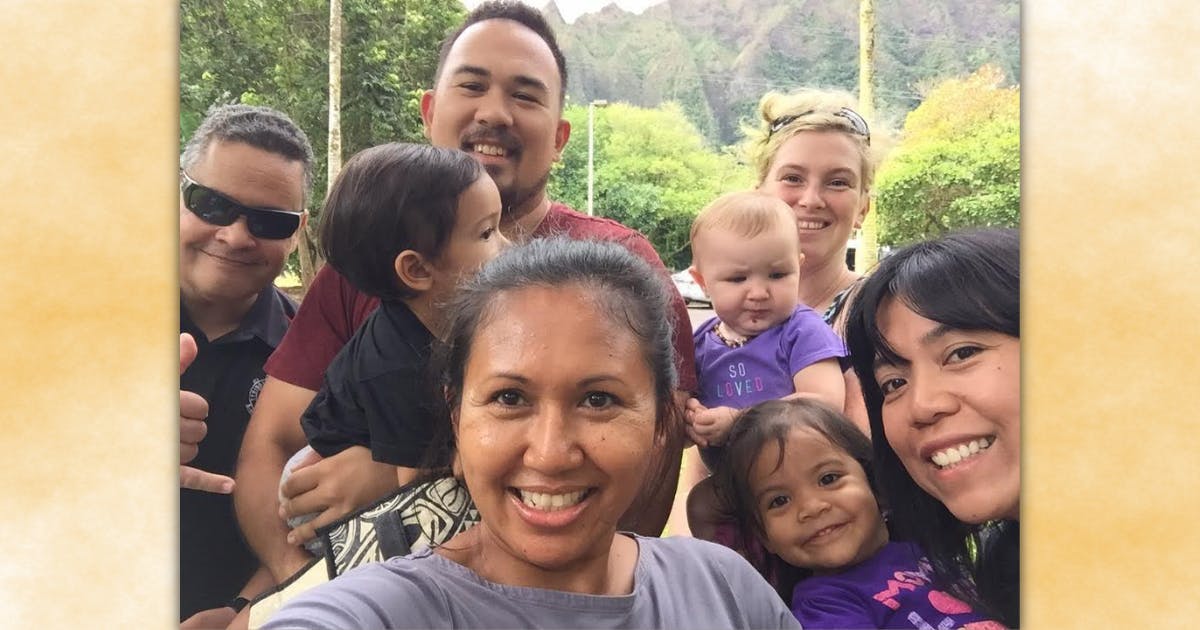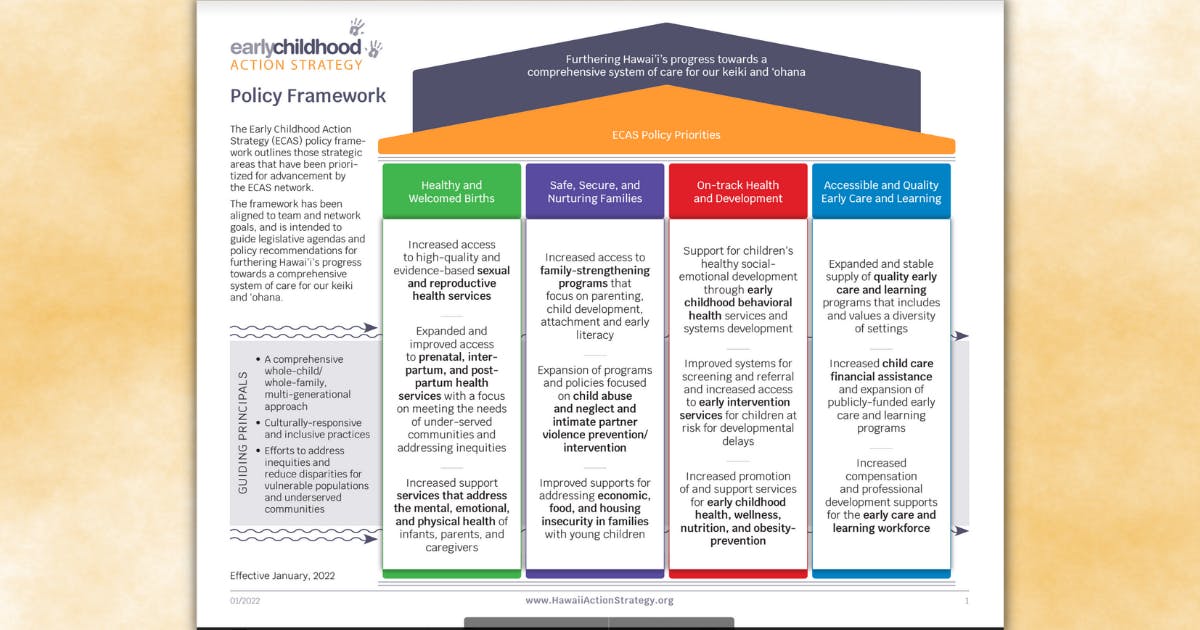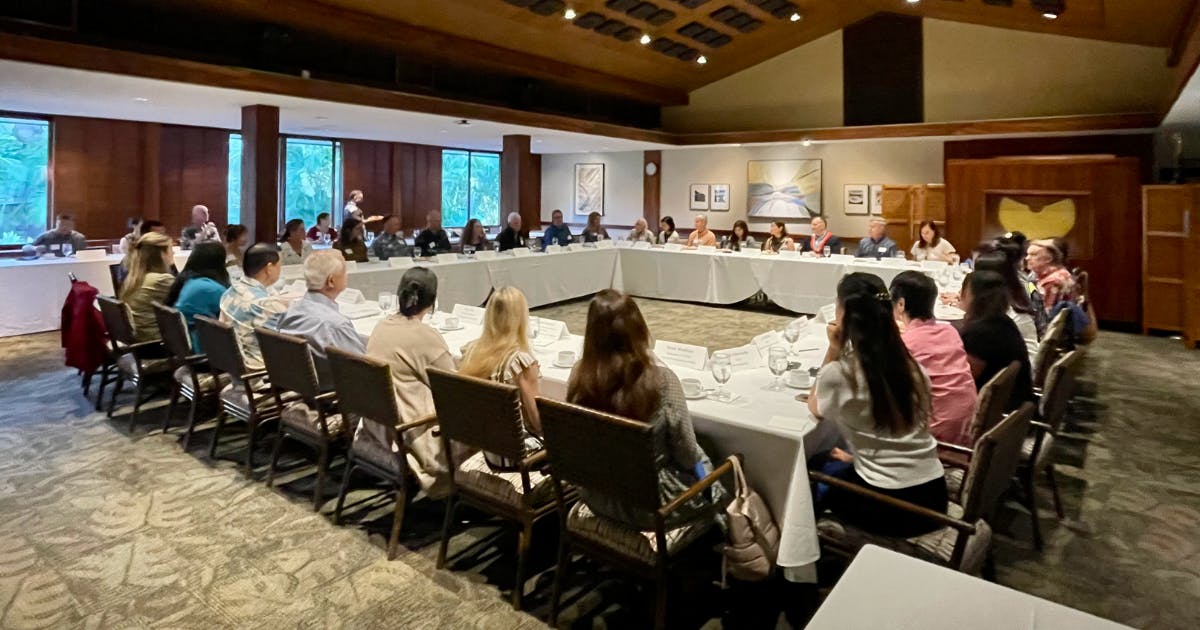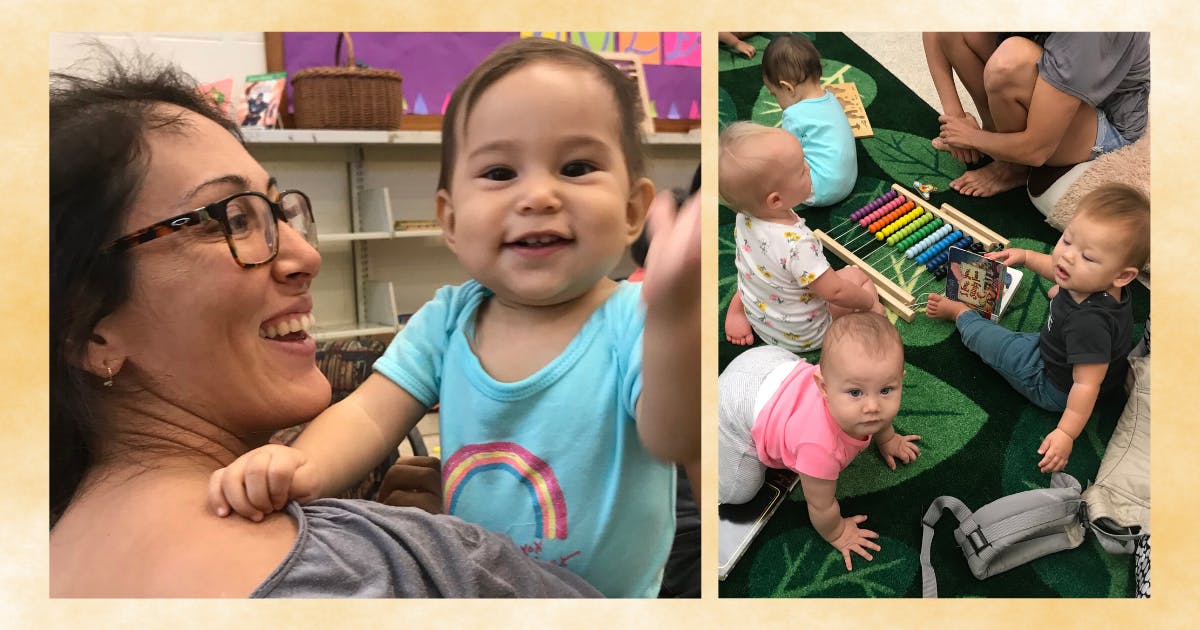Early Childhood Action Strategy (ECAS) is a government-nongovernment collaborative that works to improve the system of care for Hawai‘i’s youngest keiki, from prenatal to age eight. This impact network works with more than 350 partners across government, business, philanthropy, advocacy, direct services, and families.

Photo courtesy ECAS.
First developed in 2012 and launched in 2013, ECAS is also celebrating its 10th Anniversary. In honor of this milestone, we asked Omidyar Fellow and ECAS’s Network Design and Innovation Lead Kerrie Urosevich to share about the ECAS Network’s impact in Hawai‘i, how working in a network has advanced their efforts towards creating systems change, and what they’ve learned from connecting and convening over the last decade.
Hawai‘i Leadership Forum (HLF): Tell us about the ECAS network—what are your mission and goals?
Kerrie Urosevich (KU): ECAS’s vision is that Hawai‘i’s youngest children are healthy, safe, and ready to learn. Our mission is to bring together governmental and nongovernmental organizations to align priorities for children from prenatal to age eight and to strengthen and integrate the early childhood system by maximizing resources and growing programs to support our youngest keiki.
The ECAS network has four main goals:
- Increasing the number of babies born healthy
- Increasing the number of young keiki developing on track
- Increasing the number of keiki ready for kindergarten
- Increasing the number of keiki thriving by 3rd grade
The network is organized into eight teams with multiple subcommittees who have their own work plans, data, and outcomes. Team focus areas are inspired by Lisbeth Schorr's Pathways to Third Grade Success and include Healthy and Welcomed Births, Safe and Nurturing Families, On-Track Health and Development, Equitable Access to Programs and Services, High-Quality Programs and Services, Successful Transitions Between Programs, Infant and Early Childhood Mental Health, and the Early Childhood Funders Hui.
HLF: What are some ways that you’ve had impact as a network?
KU: The network measures its impacts using a systems-change framework of six conditions for systems change:
- Effect policy
- Prototype and scale innovative practices
- Increase investment
- Strengthen cross-sector leadership
- Improve alignment
- Shift awareness, narrative, and culture
Over the last 10 years, the network has been successful in all areas.
Effect Policy
Key wins include establishing the Executive Office on Early Learning and rolling out the pubic preschool program and the Preschool Opens Doors subsidy program, increasing protections to prevent child abuse and neglect, permanent funding for Zero to Three Court, expansion of the Supplemental Nutrition Assistance Program (SNAP) to offer “double credit” for Hawai‘i grown fresh produce, more than $200 million in expansion funds to support child care and preschool, passage of earned income tax credit and living wage bills, funding for residential programs to allow children to remain with their mothers during mental health and substance use treatment, establishing the Office of Wellness and Resilience, and Commit to Keiki wins at both the county and state levels.
Prototype and Scale Innovative Practices
ECAS has supported the development of prototypes including pharmacies directly prescribing self-administered contraceptives, pediatric breastfeeding toolkits, Words Matter LENA supporting early literacy, Ka ‘Upena shared services for the child care industry, Aloha at Home positive parenting support, farm to keiki in preschools, Makua Allies supporting moms recovering from substance addiction, and a comprehensive system of personnel development.
Increase Investment
In 2022 alone, the Early Childhood Funders Hui matched over $2 million in funds to support innovations. We also experienced significant increases in both state and county funding to support early childhood development with over $210 million in state funding and $16–$20 million in combined county funding.
Strengthen Cross-Sector Leadership
We maintain consistent participation from leaders from the Department of Health, Department of Human Services, Department of Education, the Executive Office on Early Learning, the business community, direct service providers, and philanthropy. Partners will often participate in cross-sector professional development together.
Improve Alignment
Two school readiness continuums were launched in Waimānalo and Pāhoa, connecting families with early childhood programs from birth to entry into kindergarten. Partners are working from four state-level plans and frameworks to include the Early Childhood State Plan, Hawai‘i Children’s Trust Fund Child Abuse and Neglect Prevention Framework, the Integrated Infant and Early Childhood Behavioral Health Plan, and the Hawai‘i Maternal and Infant Collaborative Strategic Plan.
Shift Awareness, Narrative, and Culture
Commit to Keiki is a nonpartisan effort toensure that candidates for elected office prioritize young children and families, no matter who gets elected. Commit to Keiki engaged with mayoral and gubernatorial candidates to educate them on the needs of young children and encouraged them to focus on prevention efforts. This saves downstream funds for crisis intervention, and it increases the chances of growing healthy, happy, and productive citizens in Hawai‘i. In addition to its work with candidates, the network also created data posters that are used consistently with media, policymakers, funders, and agency leaders.

Courtesy ECAS. Click to enlarge.
HLF: How has working as a network been more effective in creating systems change? How has it been more challenging?
KU: Working as a network allows partners to see the system from a variety of perspectives and to collectively determine which levers should be pulled and when to shift the system together. This results in streamlined investments, reduced redundanices and waste, added time and space for innovations, and allows partners to have the difficult conversations about how to remove systems-change barriers. Working in a network builds trust.
One challenge to working in a network is the additional collaboration time required when coordinating a large group of busy working professionals. Sometimes work can also move slowly if there are people actively blocking progress in the network.
HLF: How has the Omidyar Fellows program and the Forum of Fellows contributed to helping you cultivate the ECAS network? How do you envision it might contribute in the future?
KU: The Omidyar Fellows program was game changing for me as a leader in coordinating the network. The new skills I learned allowed me to hone my own leadership style. I shared the “how to host difficult conversations” toolkit broadly with backbone staff, team leads, and subcommittee leads. SMALLIFY labs allowed us to kickstart numerous projects and strenghten cross-sector leadership.
Fellows themselves have also been so generous with their time, talents, and connections. We’ve partnered with many Fellows on various projects including food distributions to families in need and maternal and child health priorities at our comprehensive health centers. Fellows have lent their voices to our Commit to Keiki effort, and partners in philanthropy have jointly funded numerous innovations. We’ve also worked with Fellows on helping to get key legislation passed. Personally, I’ve learned so much from other Fellows about hiring, staffing, organizational development, contracts management, and more.
I imagine the Omidyar Fellows program will continue to bear fruit in these ways. There is something really special about the trust that is shared among Fellows. If a Fellow calls or emails me, I will always take the call and do whatever I can to help. There’s nothing like this in my professional world and I deeply appreciate it.
HLF: What have you learned over the last decade about connecting and convening a network like ECAS?
KU: Patience is important. Getting to impact takes time and requires a set of ingredients. Our ECAS “ingredient” list includes:
- Creating a shared vision, shared language, and set of objectives for improving the system
- Creating shared mental models on how to get there
- Establishing the convening and connecting processes (facilitation, logistics, project management, etc.)
- Setting up a government-nongovernment leadership team
- Building intentional relationships across government and nongovernment partners
- Hosting difficult conversations and letting go of priorities that are stuck due to personality differences, power imbalances, or readiness
- Getting shared understanding of the enablers and inhibitors in the system
- Walking the delicate balance of government-nongovernment work and procurement
- Grant writing and funding support to innovate and scale solutions
- Engaging in policy work at all levels
- Providing professional development in systems building, conflict resolution, and project management to network partners and support Hawai‘i teams to travel together to conferences to strengthen relationships
- Having a paid backbone team
- For those not embedded in the state structure, recognizing that the state structure is where sustainability happens and how crucial it is to work closely with both state and county departments

ECAS network members convene with key government leaders. Photo courtesy ECAS.
HLF: What has been one of the most inspiring or impactful systems changes that have come out of the ECAS network?
KU: There are so many to choose from, so partners might be upset that I didn’t select their win. But if I had to select one that connects across all six systems-change components, it would be the increase in investments in young children and families over the last 10 years.
Hawai‘i has seen significant increases in both state and county funding to support early childhood development—with $210 million in state funding for preschool facilities and $16–20 million in combined county funding for staffing, childcare, family violence prevention and intervention, and co-location of affordable housing projects. In addition to individual member foundation contributions, the Early Childhood Funders Hui matches approximately $2 million in funds annually to support innovations. We’ve also seen increases in the Earned Income Tax Credit and minimum wage, a $3 million increase in Early Intervention Services, and $18 million in the Public Preschool Program.
This year, we are making a $40 million request for childcare subsidy increases, a $13 million ask in preschool operational expenses, $2.5 million for an infant and early childhood mental health program, plus state funding to support women experiencing substance use disorder and their babies, and funds to establish family resource centers in high-need communities.
These are huge wins that happened because network partners worked together to make them happen.

Photo courtesy ECAS.
HLF: What advice do you have for others who hope to create and cultivate their own impact networks?
KU: Be patient. Understand the system, its enablers, and inhibitors. Start small (SMALLIFY!). Find early adopters with “yes can” mindsets. Build the necessary infrascture. Accept that failure is part of the journey. Align work with what people are already doing so it’s a win-win for them to participate in a networked approach. Get clear on what you are measuring and how you will measure it. Be courageous in stating the difficult with grace.
Karen Pittman, recognized leader in youth development and co-founder of the Forum for Youth Investment, said, “Programmatic interventions help people beat the odds. Systemic interventions can help change their odds.” Our systems were designed to do exactly what they are doing, and systems were built by people like us. So systems can also change by people like us to be more equitable and just.
There will always be an undercurrent of where power is situated—accept it and work with or around it. It’s a long game, so celebrate the small wins. Keep people fed, have fun, be patient, take breaks, and look for those windows of opportunity where the network can move quickly for big impact. Share success and uplift partners. Systems change happens with multiple leversinside and outside of your network efforts—celebrate it all.
Arizona State University News
